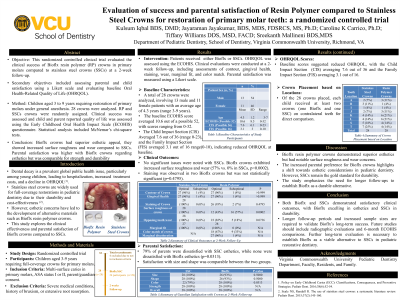Restorative
40 - Resin Polymer compared to Stainless Steel Crowns for restoration of primary molar teeth A split mouth randomized controlled trial


Kulsum Iqbal, DMD (she/her/hers)
pediatric resident
Virginia Commonwealth University, Richmond, VA
virginia commonwealth university
rockville, Maryland, United States.jpeg.jpg)
Sreekanth Mallineni, BDS, MDS, PGDipHP, AdvDipDSPaediatrDent (he/him/his)
Professor and Specialist Pediatric Dentist
Dr Sulaiman Al Habib Metical Group, Saudi Arabia
Dr Sulaiman AlHabib Medical Group, Saudi Arabia
Rayyan, Ar Riyad, Saudi Arabia- CC
Caroline Carrico, PhD
Virginia Commonwealth University
- JJ
Jayakumar Jayaraman, BDS, MDS, FDSRCS, MS, Ph.D
Virginia Commonwealth University
- TW
Tiffany Williams, DDS, MSD
Program Director, Pediatric Dental Residency
Virginia Commonwealth University School of Dentistry, Department of Pediatrics
Richmond, Virginia, United States
Presenting Author(s)
Co-Author(s)
Program Director(s)
Purpose: To evaluate the success, as well as the impact on child oral health-related quality of life comparing resin polymer (RP) crowns (NuSmile BioFlx) and stainless steel (SSC) crowns (3M ESPE) for the restoration of primary molars.
Methods: A prospective, randomized, split-mouth clinical trial was conducted in children aged 3 to 9 years requiring restoration of primary molars under general anesthesia. RP crowns were randomly assigned to one side of the mouth and SSCs were placed on the contralateral side. Clinical success was assessed at 2-weeks and recurring 6-month follow-ups. Child and parent-reported quality of life was assessed using the ECOHIS questionnaire at baseline and recurring 6-month follow-ups. Statistical analysis included McNemar’s chi-square tests
Results: Twenty four participants completed the 2-week follow-up and received 28 crowns of each type. Patients demonstrated decreased OHRQoL at baseline at both child and family levels. At the 2-week follow-up, RP crowns demonstrated significantly more issues with surface roughness (57% vs 0%, P=.0002) and issues with opposing tooth wear (18% vs 0%, P=.0736). One-third of the RP crowns had issues with the color match of the crown. None of the parents reported overall dissatisfaction with any of the crowns, although 100% indicated preference for RP crowns compared to 29% for SSC.
Conclusion: RP crowns demonstrated more issues with surface roughness and opposing tooth wear at 2 weeks follow-up. None of the parents reported overall dissatisfaction with any of the crowns, although majority of them preferred RP crowns. Parental satisfaction was higher with Bioflx crowns regarding esthetics
Identify Supporting Agency and Grant Number:

.jpg)